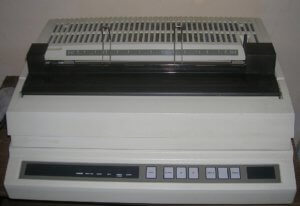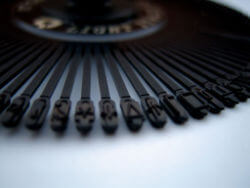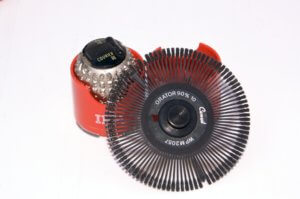Daisy Wheel Printers: History and Design

“Diablo 630, Model 630 without sheet feeder” by Canon650 is licensed under CC BY 3.0 (via Wikimedia Commons)
Daisy wheel printers were invented by David S. Lee at Diablo Data Systems in 1969. They use 96 glyphs with a template of interchangeable elements to print high quality characters similar to high-end typewriters. When first introduced, they were two times faster than their manually operated counterparts. It received its name due to its resemblance to a daisy.
Though the dot matrix and line printers were more popular for quantity printing, daisy wheels were the choice for high quality text and graphical printing. Before laser printers became popular, daisy wheel printers were favored for precision, speed, and quantity. Nowadays, you can find them in electronic typewriters.
History

Daisy Wheel Close Up Details
When Xerox acquired Diablo Data Systems in 1972, it used the daisy wheel developed by David S. Lee to improve the devices manufactured by IBM. With the Diablo 630 model impressing many companies with its high quality output and lower upkeep, daisy wheel printing became the most popular method in the industry.
Xerox used the same technology found in the Diablo 630 and incorporated it into their typewriters. Since the assembly of each unit takes less than half an hour, they were able to mass produce the units and sell them for $50 at most. However, this happened during the rise of popularity of the word processing software.
In the early 1980s, PC word processing was beating daisy wheel printing by a narrow margin. However, it was clear by 1983 that many companies were transitioning to software-based printing so fast that the typewriter itself became almost passé in half a century. Only businesses that didn’t make the jump to PCs were still using daisy wheel typewriters.
Design

Print elements for IBM Selectric typewriter and for a Canon daisy wheel printer."Impact Print Elements" by Arnold Reinhold is licensed under the CC BY 2.0
Earlier models of daisy wheel printers used fiberglass-filled nylon print wheels. This changed quickly when the Xerox OPD was introduced. A steel hub with a hard-chrome plating gave the printers the much needed durability and stability when processing consecutive papers.
The daisy wheel technology made it possible to add bold characters, different languages and intricate designs to a paper by only changing the wheel. Annually, Xerox introduced a new set of characters for different languages, which made the printer popular globally. Printing with a daisy wheel also required less time since it was capable of printing from left to right then right to left.
Thimble Printers
Though they’re closely related to daisy wheel printers, thimble printers actually use a different method. They use a thimble that resembles a cup instead of the flat wheel found in the daisy wheel. These printers were capable of holding 128 characters that, depending on the model, were separately replaceable.
Daisy wheel printers have been part of the great evolution of printers. Without such early forms of printers, we might not have the efficient printers of today.
